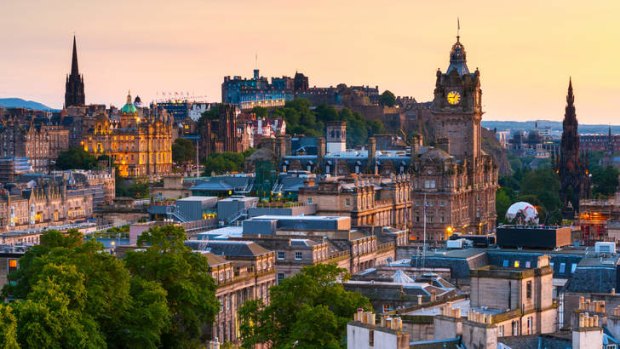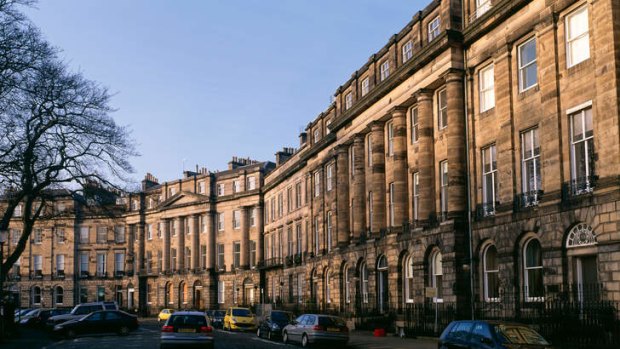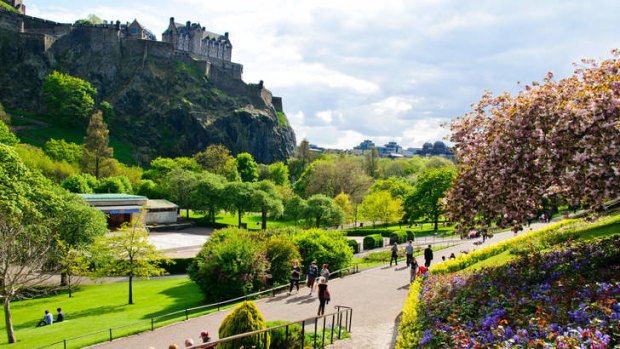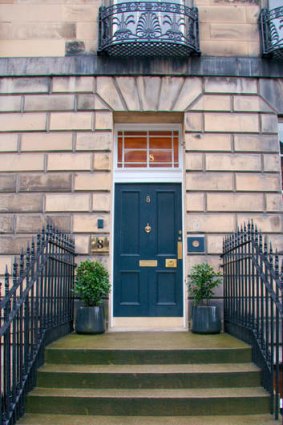
A view of New Town.Credit: Getty Images
Edinburgh's mysterious "modern" half deserves exploring, writes Anthony Dennis.
Iam standing at the lookout on Calton Hill, the irregular Georgian rooftop splendour of Edinburgh's New Town spread panoramically before me.
My 60-something guide, Ken Hanley, encourages me to clamber up a grassy rise for an even better view on this sunny morning of a city that surely possesses one of the most rousing skylines in not just Britain but all Europe. "I'd come up there with you," Ken calls to me from below, "but the wind tends to play havoc with my kilt."

Moray Place, in the New Town.Credit: Alamy
It was Robert Louis Stevenson who declared: "Edinburgh is what Paris ought to be." He may have been suffering from the sort of giddy Scottish pride that will lead Scots to the ballot box to vote for independence from the rest of Britain in September.
But, from up here, Edinburgh really is extraordinary, vaguely Parisian, even.
The Scottish capital is a city of two distinct yet complementary halves, and yet one of its halves, the New Town, remains as mysterious to many, if not most, visitors as what really lies underneath a Scotsman's kilt.

Princess Street Gardens.Credit: Alamy
Both of the towns are UNESCO World Heritage-listed, yet the New Town is often overlooked in favour of the Old Town. But with Ken's expert help, a case of out with the Old Town and in with the New Town, I am determined to uncover the New Town and its architectural glories.
My day began in the lobby of the Waldorf Astoria Caledonian Hotel, a former railway hotel with a pink Persian sandstone facade.
The Caley, as the locals fondly call it, sits in the middle between the Old Town and the New Town, its rooms affording unsurpassed views of the castle perched atop its herculean chunk of rock with its sheer vertical side.

The front door of a Georgian terrace house.Credit: Alamy
It is here that I meet Ken, a top Blue Badge guide, decked out in full Scottish regalia, right from his cap, kilt, sporran, long socks and the requisite hint of bare knees. He swears that this is normal daily attire and not a contrivance for impressionable visitors like me.
Across the street from the Caley is the gorgeously lush Princes Park Gardens that mark the dividing line between the two towns. Ken and I stride out across the narrow park that extends nearly the length of Princes Street, the New Town's busy main shopping thoroughfare and site of a new and controversial tram line.
We pass the grandiose Scott Monument, dedicated to the novelist Sir Walter Scott, who died in 1832. I am not surprised to learn that it is the biggest monument dedicated to a writer anywhere.
It is unlikely that they will receive such tributes, but novelist Alexander McCall Smith set his bestselling 44 Scotland Street book series in the New Town, as did Ian Rankin with his Inspector Rebus tomes, and J.K. Rowling calls the city home.
We head on towards Waverley Street Station, tucked away out of sight in the depression between the two towns and revealed only by its sprawling glasshouse-like roof, passing the Balmoral Hotel, Edinburgh's other grand historic railway hotel, where doormen are dressed in head-to-toe tartan.
Then it is up the slope, where Princess Street becomes Waterloo Place, and on to the 100-metre-high Calton Hill, scattered with strange neo-classical monuments.
It is a much easier hike, Ken points out, than the more well-known and well-trodden Arthur's Seat, where tourists go to view, ostensibly, the Old Town and its landmarks.
"You can't understand the New Town without understanding the Old Town," says Ken, explaining why we need to view them both from an elevated perspective.
The New Town is as old as European Australia, dating from the late 18th century, but the Old Town really is old. Its origins can be traced back to the 12th century.
The New Town's construction was prompted by a civic desire to address the crowded and unhygienic conditions of the Old Town, as well as to provide a place to house the wealthy in a more refined capital of culture and commerce, a veritable Athens of the north, and a rival, if not in size then in grandeur, to London.
Even today, there is evidence of the elitism behind the vision for the New Town, which was designed as a neat grid by a young Scottish architect called James Craig.
The sizeable and well-wooded "communal" Queen Street Gardens, in the heart of the New Town, can still be accessed only by the residents of the Georgian terraces across the cobbled street.
One of the most beautiful cultural buildings in the New Town, especially internally, is the splendid Scottish National Portrait Gallery, with its Venetian gothic facade, which opened in 1889 as the first purpose-built portrait gallery in the world, and was recently refurbished.
It is an impressive showcase of Scottish endeavour, featuring world-renowned Scots as varied as Robert Burns, Bonnie Prince Charlie, Billy Connolly and Sean Connery.
Elsewhere, with nary another tourist in sight, I pass 17 Heriot Row with its red door, once a family home of novelist Robert Louis Stevenson, one of Edinburgh's most famous sons. Another of his residences is a B&B.
I call at the Georgian House, in Charlotte Square, a few doors from Bute House, the Scottish First Minister's discrete terrace.
The Georgian House is run by the National Trust for Scotland, allowing visitors to gain a sense of what it was like for privileged citizens of Edinburgh to live in the New Town its early days.
A characteristic feature of New Town buildings, and one that has survived to this day in local building codes, is the black wrought-iron work used in the gates and fencing of terraces.
But perhaps the most curious New Town feature is the plethora of bricked-in windows - Pitt's Portraits, as they became known, named after the eponymous prime minister.
Now heritage-protected, they are a legacy of the tax avoidance in which home owners indulged to cunningly circumvent the government's practice of calculating tax based on the number of windows in a building.
Eventually, as I head into Randolph Crescent, with its serpentine row of terraces creeping up a gentle incline and dating from the early 19th century, the afternoon begins to merge with the early late-autumn evening.
It is growing cold and beginning to rain in this "city of shifting light, of changing skies, of sudden vistas", as McCall Smith once rhapsodised of Edinburgh. "A city so beautiful it breaks the heart again and again."
Anthony Dennis is Fairfax Media's national travel editor. He travelled as a guest of Railbookers, China Southern Airlines and Visit Britain.
TRIP NOTES
GETTING THERE
China Southern has regular flights to London, via Guangzhou, from Sydney and Melbourne. Australians on the Canton Route travelling to other destinations can now opt for a Guangzhou stopover with a visa-free stay for up to 72 hours. Phone 1300 889 62, see csair.com.
GETTING AROUND
Railbookers offers tailor-made rail holidays throughout Britain with a six-night holiday to London and Edinburgh starting from $930 a person, including accommodation in centrally located hotels with breakfast daily, rail travel and seat reservations. Book before June 30, 2014, and save $100 a person. Phone 1300 550 973, see railbookers.com.au.
STAYING THERE
Through Railbookers, the 241-room Waldorf Astoria Edinburgh - The Caledonian, Princes Street, is a short walk or taxi ride from Waverley Street Station, where trains arrive and depart from London; see thecaledonianedinburgh.com.
MORE INFORMATION
Sign up for the Traveller Deals newsletter
Get exclusive travel deals delivered straight to your inbox. Sign up now.